Analysis of Penalty Rate Reduction in Australian Industries
VerifiedAdded on 2023/01/06
|14
|4623
|74
Report
AI Summary
This report provides an in-depth analysis of the impact of penalty rate reductions in Australia, particularly in the context of the COVID-19 pandemic. It examines the perspectives of various stakeholders, including the government, employers, and trade unions, highlighting their arguments regarding the changes. The report explores the government's rationale for reducing penalty rates, often citing the need for economic flexibility and consumer satisfaction, especially in the travel and tourism sectors. It also details the arguments put forth by employer bodies, focusing on productivity, cost savings, and workforce management. Conversely, the report presents the unions' viewpoints, emphasizing the incentives for working unsocial hours and the potential financial impact on employees. The analysis covers the evolution of penalty rates over time and suggests recommendations on how the government can manage these rates effectively to minimize negative impacts on all parties involved.
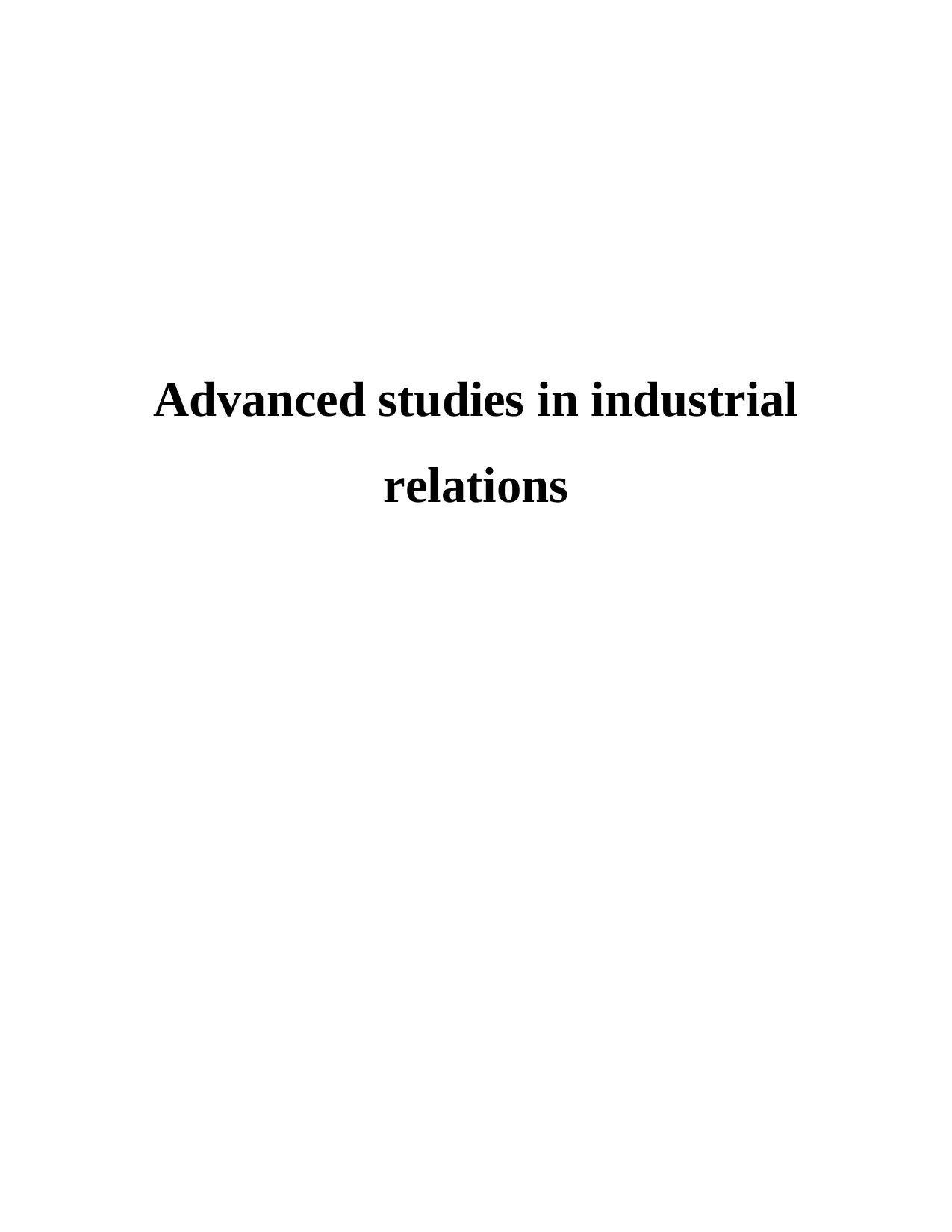
Advanced studies in industrial
relations
relations
Paraphrase This Document
Need a fresh take? Get an instant paraphrase of this document with our AI Paraphraser

EXECUTIVE SUMMARY
In the current Covid 19 pandemic it has become very difficult for different sector
employer to manage their operation in effective way. Also it has become very difficult for
employee to manage their job in the best way possible. This has eventually created good sort of
presure on the Government of nation to manage the penalty rate in a way that all interested
parties used to benefit of same. For the same reason government of Australia has reduced the
penalty rate in Australia. Present report has highlighted the point of view of different parties
impacted by reduction in the penalty rate after current pandemic in Australia. First section of
report explains the point view of Government in regard to reduction in penalty rate. After that
report has highlighted the point of view of employer and union trader in market. In the end report
suggest the best way through which impact of same can minimize by government.
In the current Covid 19 pandemic it has become very difficult for different sector
employer to manage their operation in effective way. Also it has become very difficult for
employee to manage their job in the best way possible. This has eventually created good sort of
presure on the Government of nation to manage the penalty rate in a way that all interested
parties used to benefit of same. For the same reason government of Australia has reduced the
penalty rate in Australia. Present report has highlighted the point of view of different parties
impacted by reduction in the penalty rate after current pandemic in Australia. First section of
report explains the point view of Government in regard to reduction in penalty rate. After that
report has highlighted the point of view of employer and union trader in market. In the end report
suggest the best way through which impact of same can minimize by government.
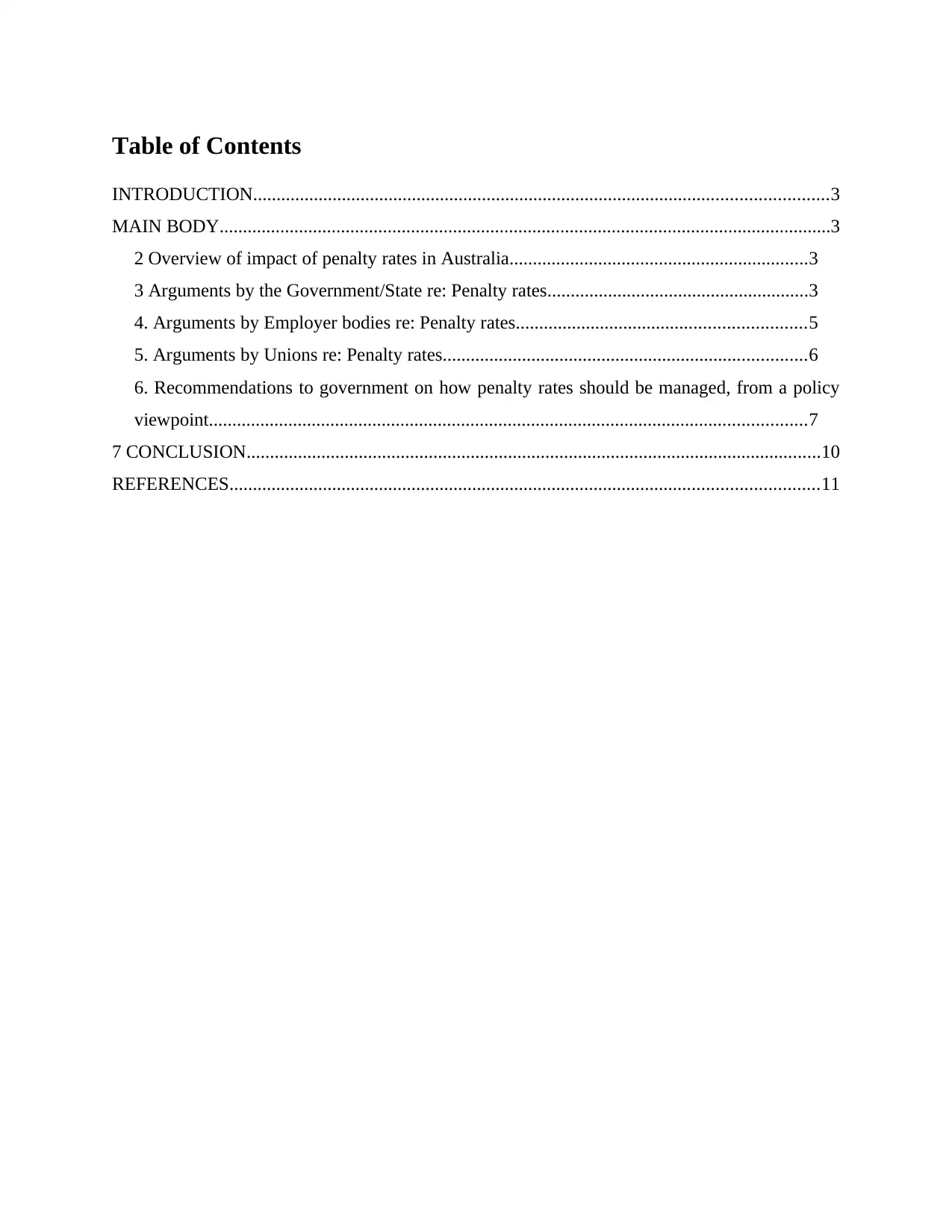
Table of Contents
INTRODUCTION...........................................................................................................................3
MAIN BODY...................................................................................................................................3
2 Overview of impact of penalty rates in Australia................................................................3
3 Arguments by the Government/State re: Penalty rates........................................................3
4. Arguments by Employer bodies re: Penalty rates..............................................................5
5. Arguments by Unions re: Penalty rates..............................................................................6
6. Recommendations to government on how penalty rates should be managed, from a policy
viewpoint................................................................................................................................7
7 CONCLUSION...........................................................................................................................10
REFERENCES..............................................................................................................................11
INTRODUCTION...........................................................................................................................3
MAIN BODY...................................................................................................................................3
2 Overview of impact of penalty rates in Australia................................................................3
3 Arguments by the Government/State re: Penalty rates........................................................3
4. Arguments by Employer bodies re: Penalty rates..............................................................5
5. Arguments by Unions re: Penalty rates..............................................................................6
6. Recommendations to government on how penalty rates should be managed, from a policy
viewpoint................................................................................................................................7
7 CONCLUSION...........................................................................................................................10
REFERENCES..............................................................................................................................11
⊘ This is a preview!⊘
Do you want full access?
Subscribe today to unlock all pages.

Trusted by 1+ million students worldwide
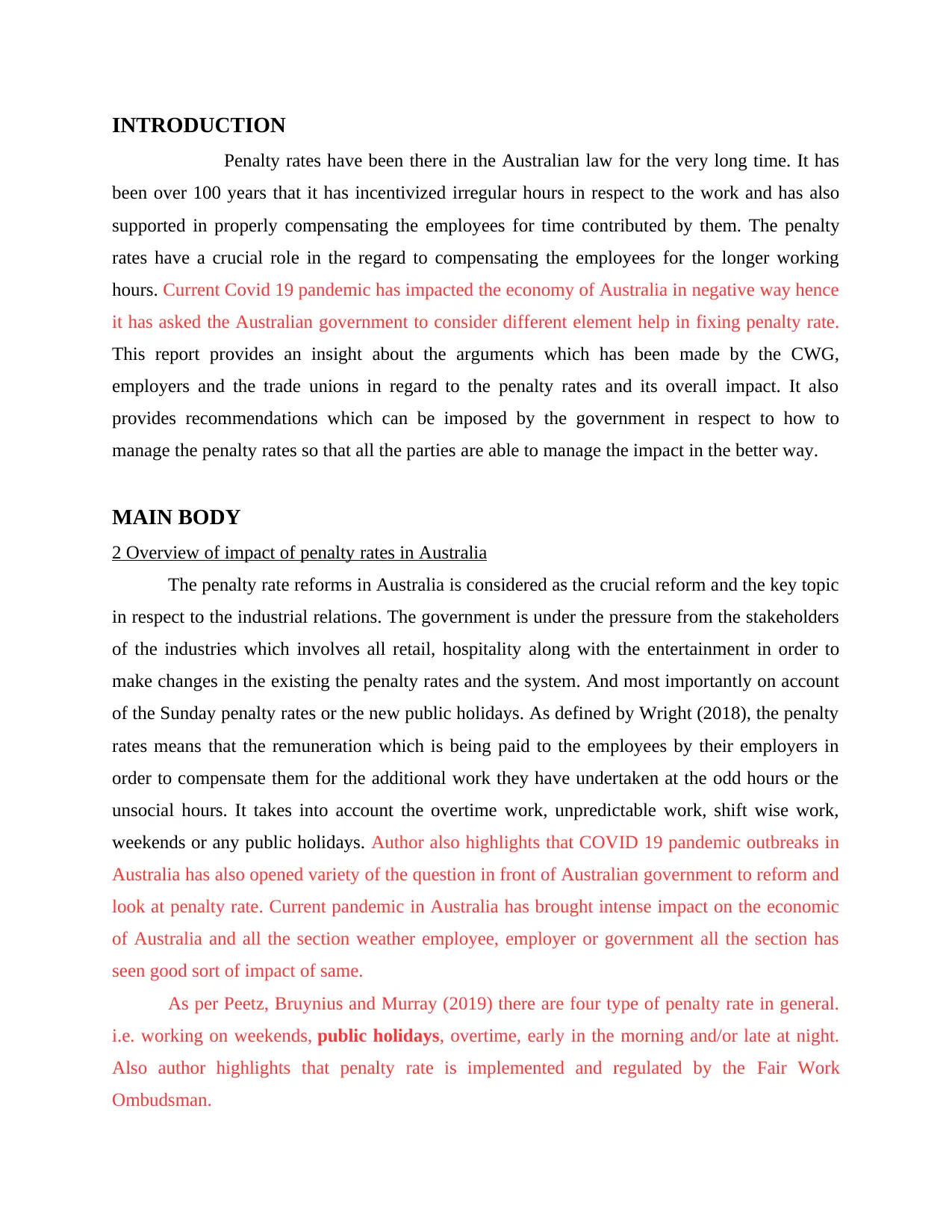
INTRODUCTION
Penalty rates have been there in the Australian law for the very long time. It has
been over 100 years that it has incentivized irregular hours in respect to the work and has also
supported in properly compensating the employees for time contributed by them. The penalty
rates have a crucial role in the regard to compensating the employees for the longer working
hours. Current Covid 19 pandemic has impacted the economy of Australia in negative way hence
it has asked the Australian government to consider different element help in fixing penalty rate.
This report provides an insight about the arguments which has been made by the CWG,
employers and the trade unions in regard to the penalty rates and its overall impact. It also
provides recommendations which can be imposed by the government in respect to how to
manage the penalty rates so that all the parties are able to manage the impact in the better way.
MAIN BODY
2 Overview of impact of penalty rates in Australia
The penalty rate reforms in Australia is considered as the crucial reform and the key topic
in respect to the industrial relations. The government is under the pressure from the stakeholders
of the industries which involves all retail, hospitality along with the entertainment in order to
make changes in the existing the penalty rates and the system. And most importantly on account
of the Sunday penalty rates or the new public holidays. As defined by Wright (2018), the penalty
rates means that the remuneration which is being paid to the employees by their employers in
order to compensate them for the additional work they have undertaken at the odd hours or the
unsocial hours. It takes into account the overtime work, unpredictable work, shift wise work,
weekends or any public holidays. Author also highlights that COVID 19 pandemic outbreaks in
Australia has also opened variety of the question in front of Australian government to reform and
look at penalty rate. Current pandemic in Australia has brought intense impact on the economic
of Australia and all the section weather employee, employer or government all the section has
seen good sort of impact of same.
As per Peetz, Bruynius and Murray (2019) there are four type of penalty rate in general.
i.e. working on weekends, public holidays, overtime, early in the morning and/or late at night.
Also author highlights that penalty rate is implemented and regulated by the Fair Work
Ombudsman.
Penalty rates have been there in the Australian law for the very long time. It has
been over 100 years that it has incentivized irregular hours in respect to the work and has also
supported in properly compensating the employees for time contributed by them. The penalty
rates have a crucial role in the regard to compensating the employees for the longer working
hours. Current Covid 19 pandemic has impacted the economy of Australia in negative way hence
it has asked the Australian government to consider different element help in fixing penalty rate.
This report provides an insight about the arguments which has been made by the CWG,
employers and the trade unions in regard to the penalty rates and its overall impact. It also
provides recommendations which can be imposed by the government in respect to how to
manage the penalty rates so that all the parties are able to manage the impact in the better way.
MAIN BODY
2 Overview of impact of penalty rates in Australia
The penalty rate reforms in Australia is considered as the crucial reform and the key topic
in respect to the industrial relations. The government is under the pressure from the stakeholders
of the industries which involves all retail, hospitality along with the entertainment in order to
make changes in the existing the penalty rates and the system. And most importantly on account
of the Sunday penalty rates or the new public holidays. As defined by Wright (2018), the penalty
rates means that the remuneration which is being paid to the employees by their employers in
order to compensate them for the additional work they have undertaken at the odd hours or the
unsocial hours. It takes into account the overtime work, unpredictable work, shift wise work,
weekends or any public holidays. Author also highlights that COVID 19 pandemic outbreaks in
Australia has also opened variety of the question in front of Australian government to reform and
look at penalty rate. Current pandemic in Australia has brought intense impact on the economic
of Australia and all the section weather employee, employer or government all the section has
seen good sort of impact of same.
As per Peetz, Bruynius and Murray (2019) there are four type of penalty rate in general.
i.e. working on weekends, public holidays, overtime, early in the morning and/or late at night.
Also author highlights that penalty rate is implemented and regulated by the Fair Work
Ombudsman.
Paraphrase This Document
Need a fresh take? Get an instant paraphrase of this document with our AI Paraphraser

3 Arguments by the Government/State re: Penalty rates
In the published article Zhou, J & et.al., (2017) Government is in the favor of the decision
in regard to reducing the penalty rate of Sunday and maintaining the same after such pandemic
situation as well in Australia, as Government highlights the question that is Sunday is that
important than Saturday after such type of pandemic?, Government explained that decision of
having the higher penalty rate on Sunday was also taken on the basis of the same question only.
Government generally passes on the point that Sunday is no different from the Saturday and
penalty rate should be same for both the days. At the same time it was also analyzed from the
Government release that reason behind this sort of penalty rate cut is that there will be many
employees who will become over depended on the earning of weekend and generally do not
work rest of the week. As after this sort of pandemic it would become very difficult for the
employee to get good full time job. This ultimately driving the nation economy in a situation
where there is flexibility in presence of Human resources in the market, this has eventually
driven the Government to take this sort of the decision in the market. At the same time
Sinnasamy & Bidin, (2017) explain that opposition parties are not in the favor of this decision, as
they are argued that bringing this sort of changes in the penalty rate will only impact the one who
are not clear about their career or the one who used to work on the part-time basis. Hence, they
mean that this decision will not impact the one who are settled enough and earning good sort of
money, will only impacts the one who are not having permanent job.
MORE & POWER, (2018) highlights that reduction in penalty rate of public holiday is
generally a decision which has been taken to improve amount of travel and consumer satisfaction
in the market. Government has highlights that reduction in penalty rate of public holiday will
prompt the company to recruit more number of employee in the organization, this will eventually
help the company in managing the customer satisfaction in market. As more number of staff
member will be their to answer the different query and improve the amount of the interest of
different consumer in the market in a long run. This is very important for the government as well
reason behind highlighting the same is that due to current pandemic in the market it will get
difficult for government to earn the trust of traveler again. As travel and tourism industry is one
of the most important sort of industry of Australia in long run. Hence, government was also
having the information that bringing this sort of change in the policy may also help the nation in
seeing good level of tourism. At the same time opposition party was not in the favor of the same
In the published article Zhou, J & et.al., (2017) Government is in the favor of the decision
in regard to reducing the penalty rate of Sunday and maintaining the same after such pandemic
situation as well in Australia, as Government highlights the question that is Sunday is that
important than Saturday after such type of pandemic?, Government explained that decision of
having the higher penalty rate on Sunday was also taken on the basis of the same question only.
Government generally passes on the point that Sunday is no different from the Saturday and
penalty rate should be same for both the days. At the same time it was also analyzed from the
Government release that reason behind this sort of penalty rate cut is that there will be many
employees who will become over depended on the earning of weekend and generally do not
work rest of the week. As after this sort of pandemic it would become very difficult for the
employee to get good full time job. This ultimately driving the nation economy in a situation
where there is flexibility in presence of Human resources in the market, this has eventually
driven the Government to take this sort of the decision in the market. At the same time
Sinnasamy & Bidin, (2017) explain that opposition parties are not in the favor of this decision, as
they are argued that bringing this sort of changes in the penalty rate will only impact the one who
are not clear about their career or the one who used to work on the part-time basis. Hence, they
mean that this decision will not impact the one who are settled enough and earning good sort of
money, will only impacts the one who are not having permanent job.
MORE & POWER, (2018) highlights that reduction in penalty rate of public holiday is
generally a decision which has been taken to improve amount of travel and consumer satisfaction
in the market. Government has highlights that reduction in penalty rate of public holiday will
prompt the company to recruit more number of employee in the organization, this will eventually
help the company in managing the customer satisfaction in market. As more number of staff
member will be their to answer the different query and improve the amount of the interest of
different consumer in the market in a long run. This is very important for the government as well
reason behind highlighting the same is that due to current pandemic in the market it will get
difficult for government to earn the trust of traveler again. As travel and tourism industry is one
of the most important sort of industry of Australia in long run. Hence, government was also
having the information that bringing this sort of change in the policy may also help the nation in
seeing good level of tourism. At the same time opposition party was not in the favor of the same
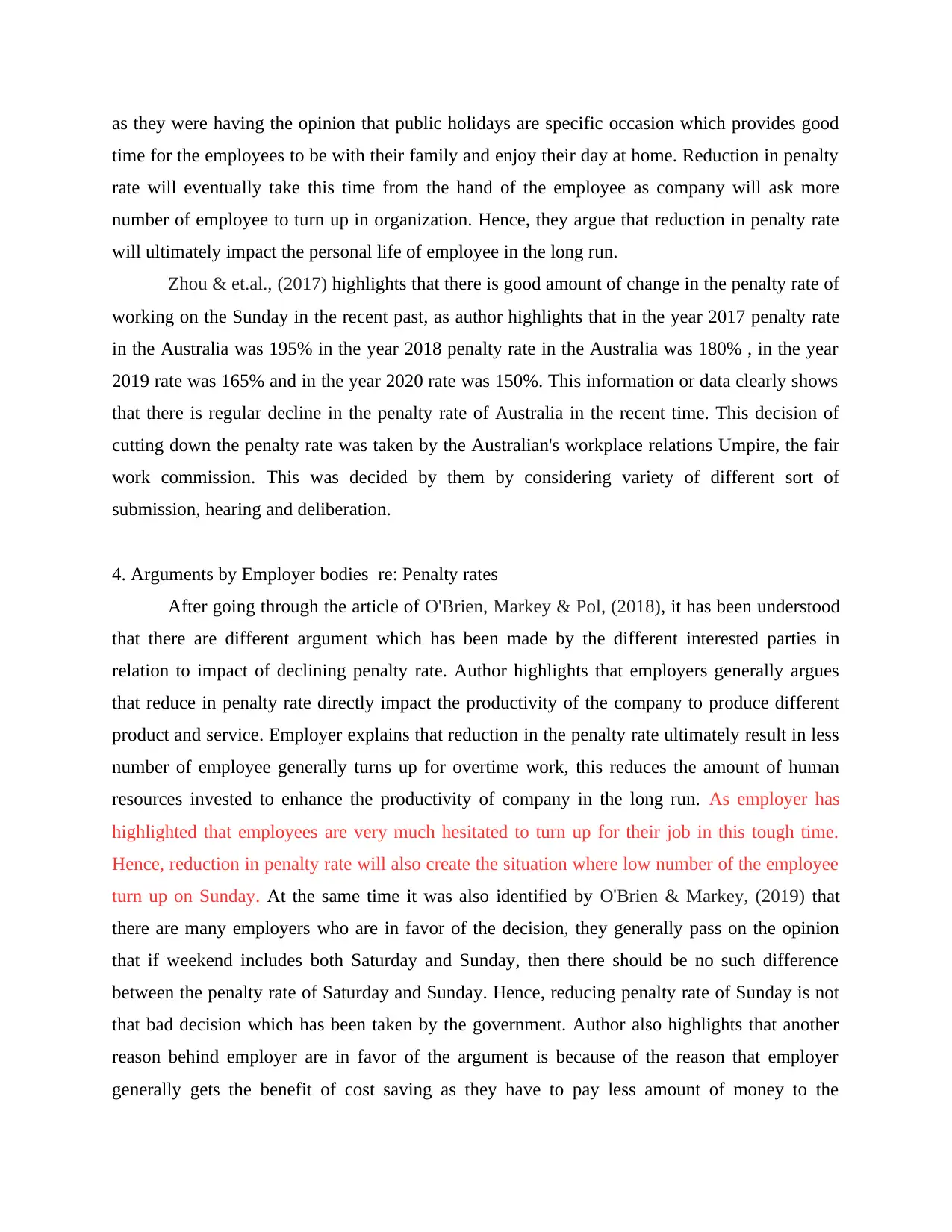
as they were having the opinion that public holidays are specific occasion which provides good
time for the employees to be with their family and enjoy their day at home. Reduction in penalty
rate will eventually take this time from the hand of the employee as company will ask more
number of employee to turn up in organization. Hence, they argue that reduction in penalty rate
will ultimately impact the personal life of employee in the long run.
Zhou & et.al., (2017) highlights that there is good amount of change in the penalty rate of
working on the Sunday in the recent past, as author highlights that in the year 2017 penalty rate
in the Australia was 195% in the year 2018 penalty rate in the Australia was 180% , in the year
2019 rate was 165% and in the year 2020 rate was 150%. This information or data clearly shows
that there is regular decline in the penalty rate of Australia in the recent time. This decision of
cutting down the penalty rate was taken by the Australian's workplace relations Umpire, the fair
work commission. This was decided by them by considering variety of different sort of
submission, hearing and deliberation.
4. Arguments by Employer bodies re: Penalty rates
After going through the article of O'Brien, Markey & Pol, (2018), it has been understood
that there are different argument which has been made by the different interested parties in
relation to impact of declining penalty rate. Author highlights that employers generally argues
that reduce in penalty rate directly impact the productivity of the company to produce different
product and service. Employer explains that reduction in the penalty rate ultimately result in less
number of employee generally turns up for overtime work, this reduces the amount of human
resources invested to enhance the productivity of company in the long run. As employer has
highlighted that employees are very much hesitated to turn up for their job in this tough time.
Hence, reduction in penalty rate will also create the situation where low number of the employee
turn up on Sunday. At the same time it was also identified by O'Brien & Markey, (2019) that
there are many employers who are in favor of the decision, they generally pass on the opinion
that if weekend includes both Saturday and Sunday, then there should be no such difference
between the penalty rate of Saturday and Sunday. Hence, reducing penalty rate of Sunday is not
that bad decision which has been taken by the government. Author also highlights that another
reason behind employer are in favor of the argument is because of the reason that employer
generally gets the benefit of cost saving as they have to pay less amount of money to the
time for the employees to be with their family and enjoy their day at home. Reduction in penalty
rate will eventually take this time from the hand of the employee as company will ask more
number of employee to turn up in organization. Hence, they argue that reduction in penalty rate
will ultimately impact the personal life of employee in the long run.
Zhou & et.al., (2017) highlights that there is good amount of change in the penalty rate of
working on the Sunday in the recent past, as author highlights that in the year 2017 penalty rate
in the Australia was 195% in the year 2018 penalty rate in the Australia was 180% , in the year
2019 rate was 165% and in the year 2020 rate was 150%. This information or data clearly shows
that there is regular decline in the penalty rate of Australia in the recent time. This decision of
cutting down the penalty rate was taken by the Australian's workplace relations Umpire, the fair
work commission. This was decided by them by considering variety of different sort of
submission, hearing and deliberation.
4. Arguments by Employer bodies re: Penalty rates
After going through the article of O'Brien, Markey & Pol, (2018), it has been understood
that there are different argument which has been made by the different interested parties in
relation to impact of declining penalty rate. Author highlights that employers generally argues
that reduce in penalty rate directly impact the productivity of the company to produce different
product and service. Employer explains that reduction in the penalty rate ultimately result in less
number of employee generally turns up for overtime work, this reduces the amount of human
resources invested to enhance the productivity of company in the long run. As employer has
highlighted that employees are very much hesitated to turn up for their job in this tough time.
Hence, reduction in penalty rate will also create the situation where low number of the employee
turn up on Sunday. At the same time it was also identified by O'Brien & Markey, (2019) that
there are many employers who are in favor of the decision, they generally pass on the opinion
that if weekend includes both Saturday and Sunday, then there should be no such difference
between the penalty rate of Saturday and Sunday. Hence, reducing penalty rate of Sunday is not
that bad decision which has been taken by the government. Author also highlights that another
reason behind employer are in favor of the argument is because of the reason that employer
generally gets the benefit of cost saving as they have to pay less amount of money to the
⊘ This is a preview!⊘
Do you want full access?
Subscribe today to unlock all pages.

Trusted by 1+ million students worldwide
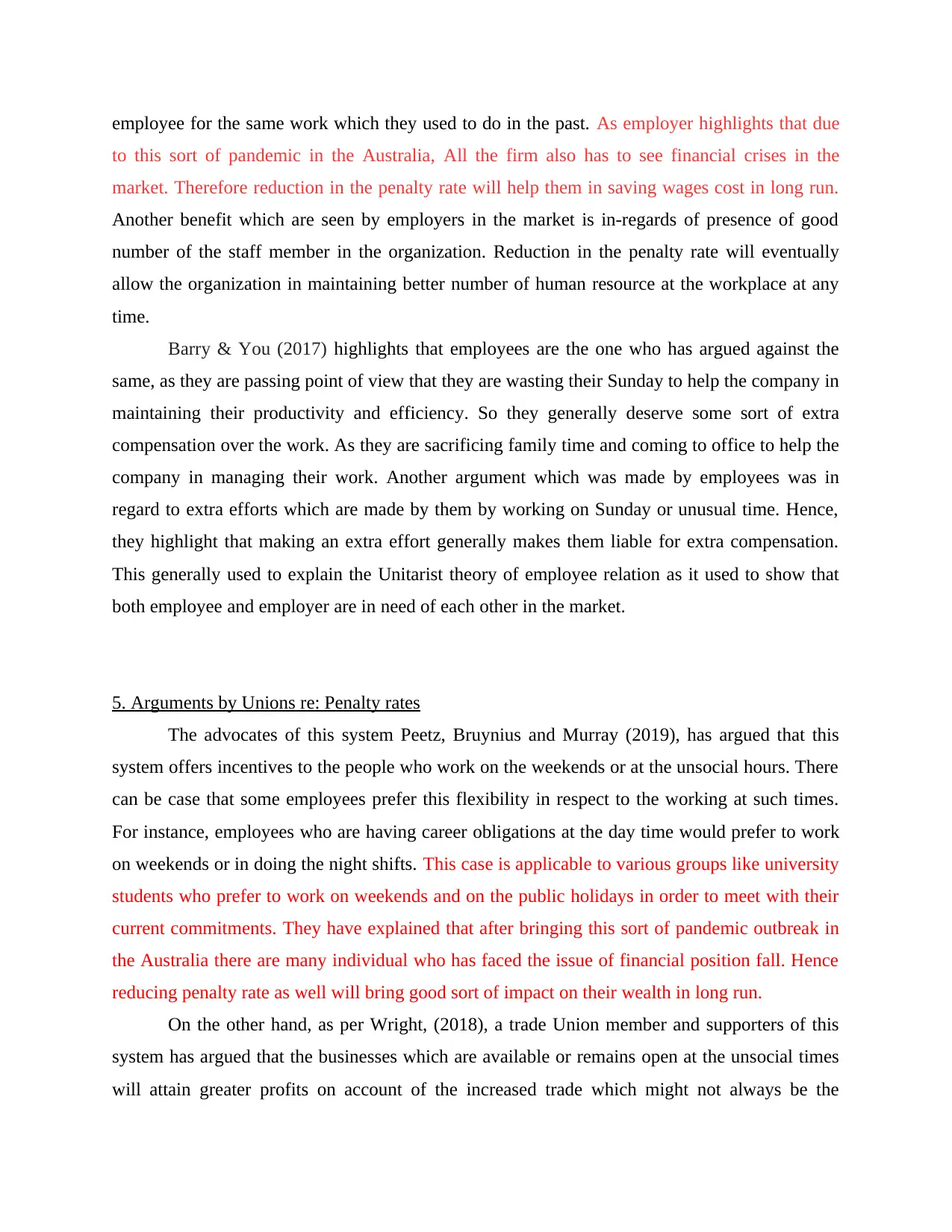
employee for the same work which they used to do in the past. As employer highlights that due
to this sort of pandemic in the Australia, All the firm also has to see financial crises in the
market. Therefore reduction in the penalty rate will help them in saving wages cost in long run.
Another benefit which are seen by employers in the market is in-regards of presence of good
number of the staff member in the organization. Reduction in the penalty rate will eventually
allow the organization in maintaining better number of human resource at the workplace at any
time.
Barry & You (2017) highlights that employees are the one who has argued against the
same, as they are passing point of view that they are wasting their Sunday to help the company in
maintaining their productivity and efficiency. So they generally deserve some sort of extra
compensation over the work. As they are sacrificing family time and coming to office to help the
company in managing their work. Another argument which was made by employees was in
regard to extra efforts which are made by them by working on Sunday or unusual time. Hence,
they highlight that making an extra effort generally makes them liable for extra compensation.
This generally used to explain the Unitarist theory of employee relation as it used to show that
both employee and employer are in need of each other in the market.
5. Arguments by Unions re: Penalty rates
The advocates of this system Peetz, Bruynius and Murray (2019), has argued that this
system offers incentives to the people who work on the weekends or at the unsocial hours. There
can be case that some employees prefer this flexibility in respect to the working at such times.
For instance, employees who are having career obligations at the day time would prefer to work
on weekends or in doing the night shifts. This case is applicable to various groups like university
students who prefer to work on weekends and on the public holidays in order to meet with their
current commitments. They have explained that after bringing this sort of pandemic outbreak in
the Australia there are many individual who has faced the issue of financial position fall. Hence
reducing penalty rate as well will bring good sort of impact on their wealth in long run.
On the other hand, as per Wright, (2018), a trade Union member and supporters of this
system has argued that the businesses which are available or remains open at the unsocial times
will attain greater profits on account of the increased trade which might not always be the
to this sort of pandemic in the Australia, All the firm also has to see financial crises in the
market. Therefore reduction in the penalty rate will help them in saving wages cost in long run.
Another benefit which are seen by employers in the market is in-regards of presence of good
number of the staff member in the organization. Reduction in the penalty rate will eventually
allow the organization in maintaining better number of human resource at the workplace at any
time.
Barry & You (2017) highlights that employees are the one who has argued against the
same, as they are passing point of view that they are wasting their Sunday to help the company in
maintaining their productivity and efficiency. So they generally deserve some sort of extra
compensation over the work. As they are sacrificing family time and coming to office to help the
company in managing their work. Another argument which was made by employees was in
regard to extra efforts which are made by them by working on Sunday or unusual time. Hence,
they highlight that making an extra effort generally makes them liable for extra compensation.
This generally used to explain the Unitarist theory of employee relation as it used to show that
both employee and employer are in need of each other in the market.
5. Arguments by Unions re: Penalty rates
The advocates of this system Peetz, Bruynius and Murray (2019), has argued that this
system offers incentives to the people who work on the weekends or at the unsocial hours. There
can be case that some employees prefer this flexibility in respect to the working at such times.
For instance, employees who are having career obligations at the day time would prefer to work
on weekends or in doing the night shifts. This case is applicable to various groups like university
students who prefer to work on weekends and on the public holidays in order to meet with their
current commitments. They have explained that after bringing this sort of pandemic outbreak in
the Australia there are many individual who has faced the issue of financial position fall. Hence
reducing penalty rate as well will bring good sort of impact on their wealth in long run.
On the other hand, as per Wright, (2018), a trade Union member and supporters of this
system has argued that the businesses which are available or remains open at the unsocial times
will attain greater profits on account of the increased trade which might not always be the
Paraphrase This Document
Need a fresh take? Get an instant paraphrase of this document with our AI Paraphraser
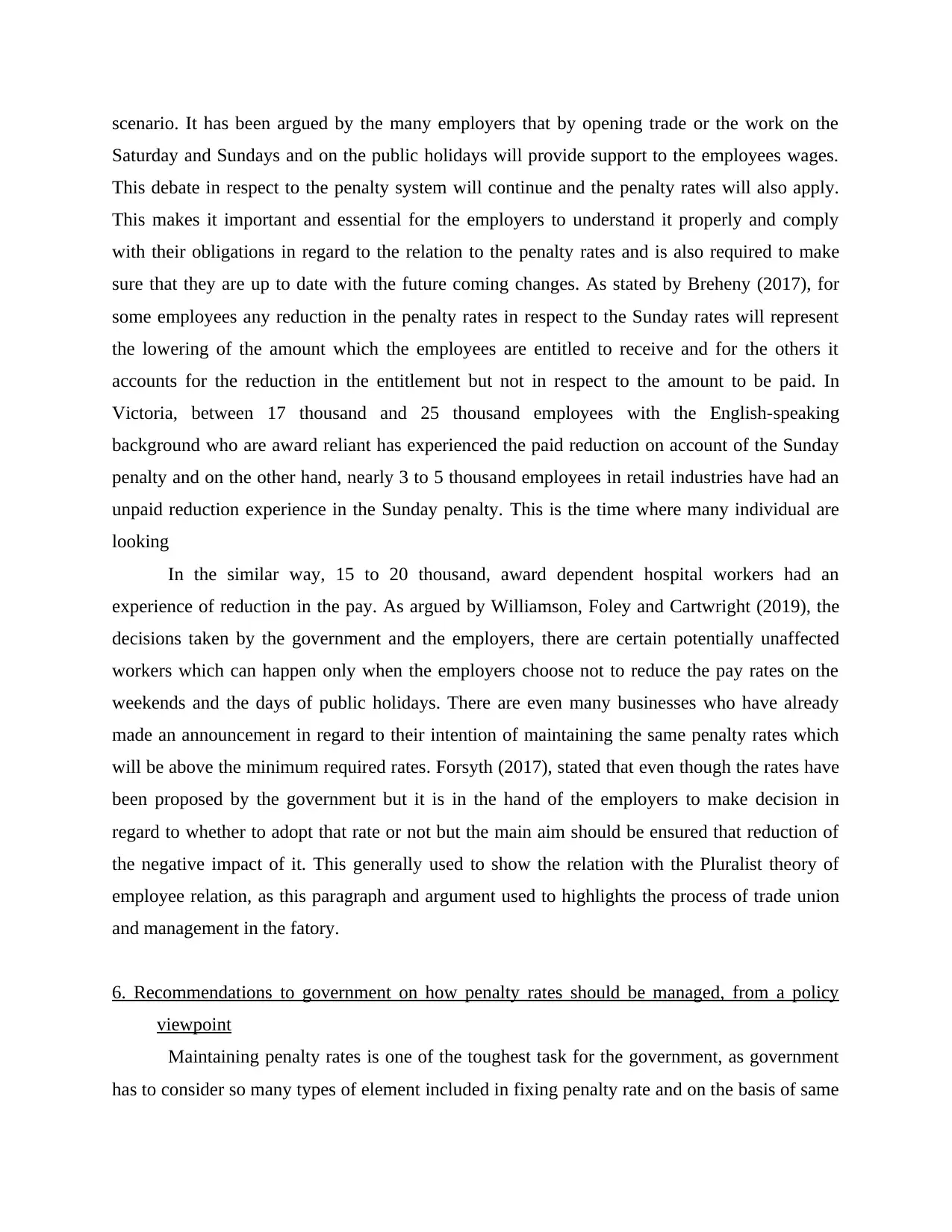
scenario. It has been argued by the many employers that by opening trade or the work on the
Saturday and Sundays and on the public holidays will provide support to the employees wages.
This debate in respect to the penalty system will continue and the penalty rates will also apply.
This makes it important and essential for the employers to understand it properly and comply
with their obligations in regard to the relation to the penalty rates and is also required to make
sure that they are up to date with the future coming changes. As stated by Breheny (2017), for
some employees any reduction in the penalty rates in respect to the Sunday rates will represent
the lowering of the amount which the employees are entitled to receive and for the others it
accounts for the reduction in the entitlement but not in respect to the amount to be paid. In
Victoria, between 17 thousand and 25 thousand employees with the English-speaking
background who are award reliant has experienced the paid reduction on account of the Sunday
penalty and on the other hand, nearly 3 to 5 thousand employees in retail industries have had an
unpaid reduction experience in the Sunday penalty. This is the time where many individual are
looking
In the similar way, 15 to 20 thousand, award dependent hospital workers had an
experience of reduction in the pay. As argued by Williamson, Foley and Cartwright (2019), the
decisions taken by the government and the employers, there are certain potentially unaffected
workers which can happen only when the employers choose not to reduce the pay rates on the
weekends and the days of public holidays. There are even many businesses who have already
made an announcement in regard to their intention of maintaining the same penalty rates which
will be above the minimum required rates. Forsyth (2017), stated that even though the rates have
been proposed by the government but it is in the hand of the employers to make decision in
regard to whether to adopt that rate or not but the main aim should be ensured that reduction of
the negative impact of it. This generally used to show the relation with the Pluralist theory of
employee relation, as this paragraph and argument used to highlights the process of trade union
and management in the fatory.
6. Recommendations to government on how penalty rates should be managed, from a policy
viewpoint
Maintaining penalty rates is one of the toughest task for the government, as government
has to consider so many types of element included in fixing penalty rate and on the basis of same
Saturday and Sundays and on the public holidays will provide support to the employees wages.
This debate in respect to the penalty system will continue and the penalty rates will also apply.
This makes it important and essential for the employers to understand it properly and comply
with their obligations in regard to the relation to the penalty rates and is also required to make
sure that they are up to date with the future coming changes. As stated by Breheny (2017), for
some employees any reduction in the penalty rates in respect to the Sunday rates will represent
the lowering of the amount which the employees are entitled to receive and for the others it
accounts for the reduction in the entitlement but not in respect to the amount to be paid. In
Victoria, between 17 thousand and 25 thousand employees with the English-speaking
background who are award reliant has experienced the paid reduction on account of the Sunday
penalty and on the other hand, nearly 3 to 5 thousand employees in retail industries have had an
unpaid reduction experience in the Sunday penalty. This is the time where many individual are
looking
In the similar way, 15 to 20 thousand, award dependent hospital workers had an
experience of reduction in the pay. As argued by Williamson, Foley and Cartwright (2019), the
decisions taken by the government and the employers, there are certain potentially unaffected
workers which can happen only when the employers choose not to reduce the pay rates on the
weekends and the days of public holidays. There are even many businesses who have already
made an announcement in regard to their intention of maintaining the same penalty rates which
will be above the minimum required rates. Forsyth (2017), stated that even though the rates have
been proposed by the government but it is in the hand of the employers to make decision in
regard to whether to adopt that rate or not but the main aim should be ensured that reduction of
the negative impact of it. This generally used to show the relation with the Pluralist theory of
employee relation, as this paragraph and argument used to highlights the process of trade union
and management in the fatory.
6. Recommendations to government on how penalty rates should be managed, from a policy
viewpoint
Maintaining penalty rates is one of the toughest task for the government, as government
has to consider so many types of element included in fixing penalty rate and on the basis of same
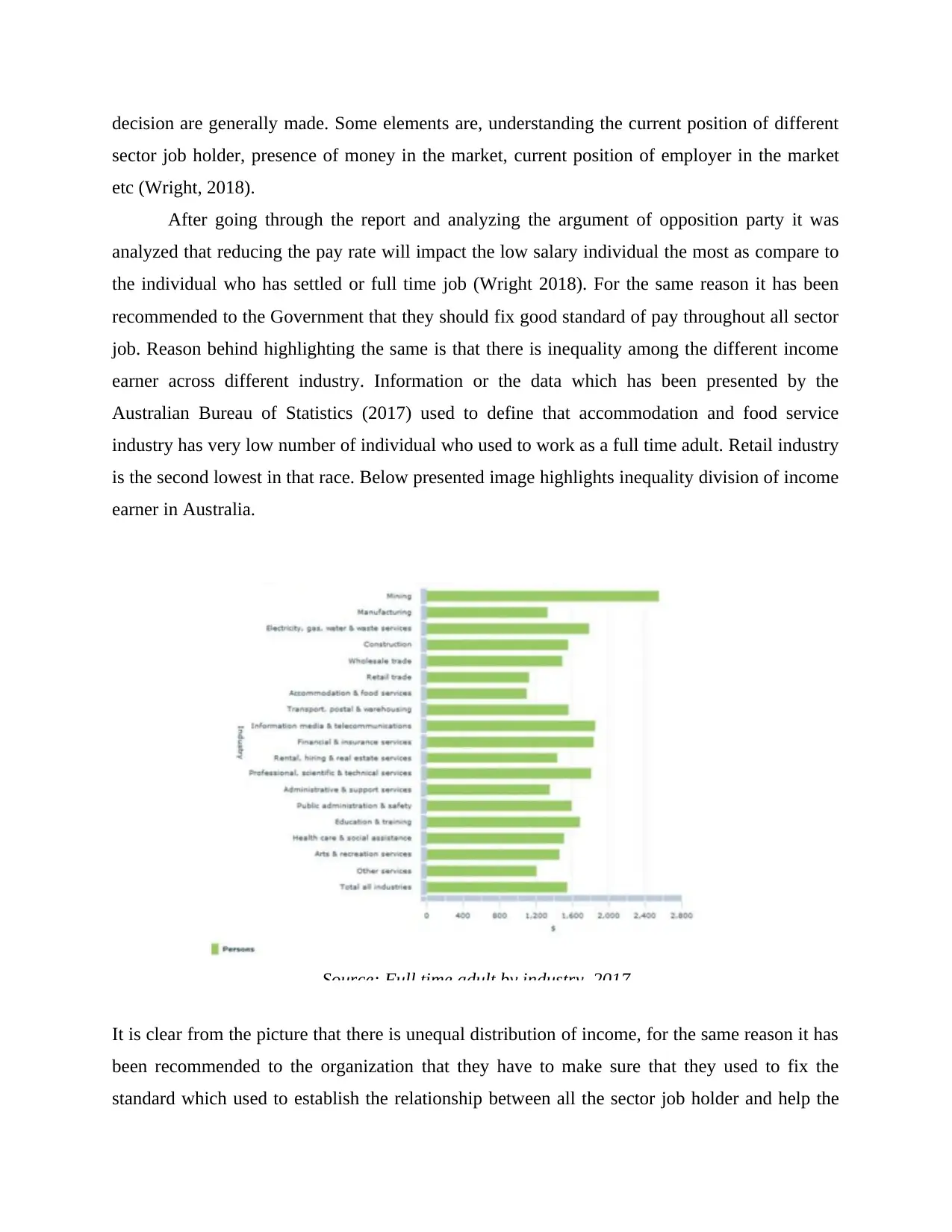
decision are generally made. Some elements are, understanding the current position of different
sector job holder, presence of money in the market, current position of employer in the market
etc (Wright, 2018).
After going through the report and analyzing the argument of opposition party it was
analyzed that reducing the pay rate will impact the low salary individual the most as compare to
the individual who has settled or full time job (Wright 2018). For the same reason it has been
recommended to the Government that they should fix good standard of pay throughout all sector
job. Reason behind highlighting the same is that there is inequality among the different income
earner across different industry. Information or the data which has been presented by the
Australian Bureau of Statistics (2017) used to define that accommodation and food service
industry has very low number of individual who used to work as a full time adult. Retail industry
is the second lowest in that race. Below presented image highlights inequality division of income
earner in Australia.
It is clear from the picture that there is unequal distribution of income, for the same reason it has
been recommended to the organization that they have to make sure that they used to fix the
standard which used to establish the relationship between all the sector job holder and help the
Source: Full time adult by industry, 2017
sector job holder, presence of money in the market, current position of employer in the market
etc (Wright, 2018).
After going through the report and analyzing the argument of opposition party it was
analyzed that reducing the pay rate will impact the low salary individual the most as compare to
the individual who has settled or full time job (Wright 2018). For the same reason it has been
recommended to the Government that they should fix good standard of pay throughout all sector
job. Reason behind highlighting the same is that there is inequality among the different income
earner across different industry. Information or the data which has been presented by the
Australian Bureau of Statistics (2017) used to define that accommodation and food service
industry has very low number of individual who used to work as a full time adult. Retail industry
is the second lowest in that race. Below presented image highlights inequality division of income
earner in Australia.
It is clear from the picture that there is unequal distribution of income, for the same reason it has
been recommended to the organization that they have to make sure that they used to fix the
standard which used to establish the relationship between all the sector job holder and help the
Source: Full time adult by industry, 2017
⊘ This is a preview!⊘
Do you want full access?
Subscribe today to unlock all pages.

Trusted by 1+ million students worldwide
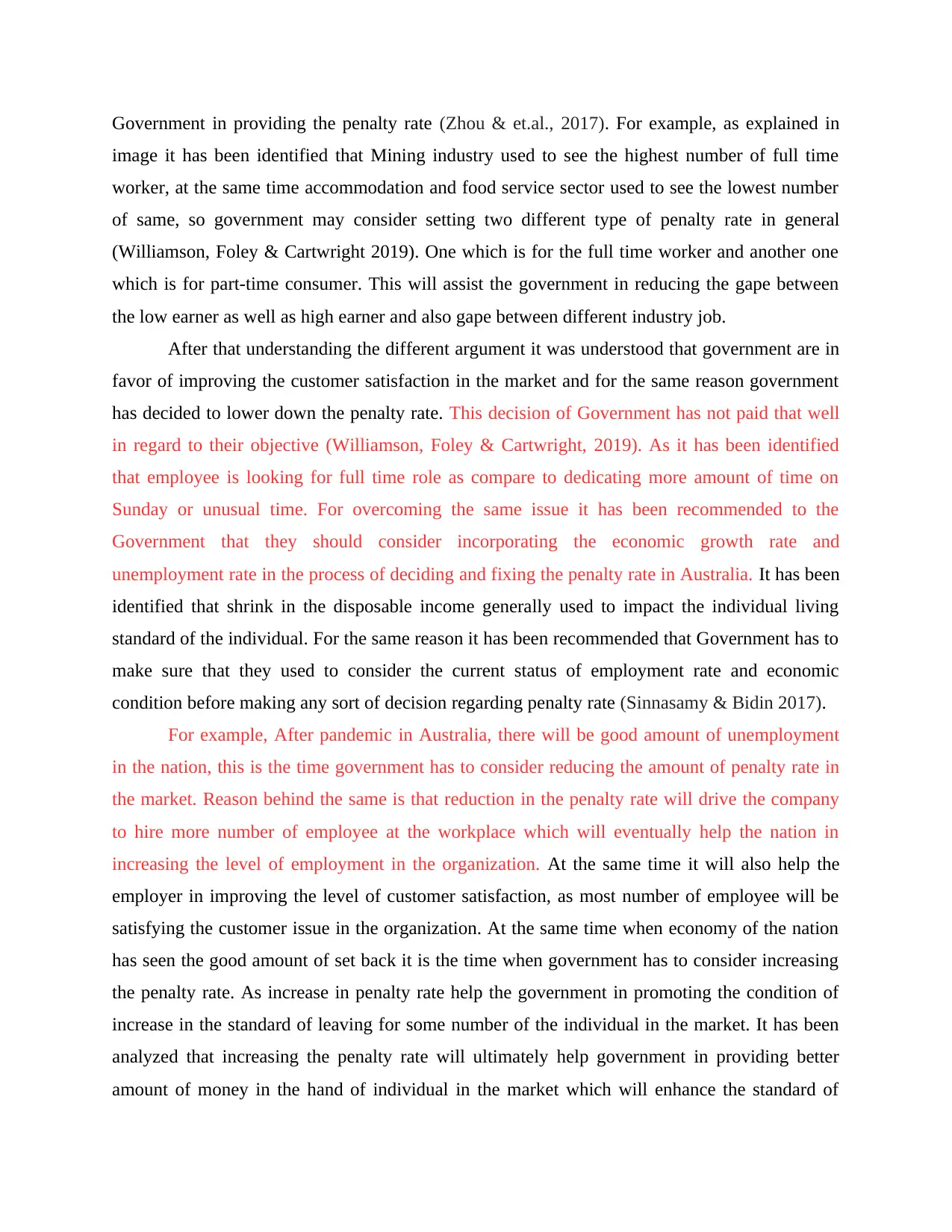
Government in providing the penalty rate (Zhou & et.al., 2017). For example, as explained in
image it has been identified that Mining industry used to see the highest number of full time
worker, at the same time accommodation and food service sector used to see the lowest number
of same, so government may consider setting two different type of penalty rate in general
(Williamson, Foley & Cartwright 2019). One which is for the full time worker and another one
which is for part-time consumer. This will assist the government in reducing the gape between
the low earner as well as high earner and also gape between different industry job.
After that understanding the different argument it was understood that government are in
favor of improving the customer satisfaction in the market and for the same reason government
has decided to lower down the penalty rate. This decision of Government has not paid that well
in regard to their objective (Williamson, Foley & Cartwright, 2019). As it has been identified
that employee is looking for full time role as compare to dedicating more amount of time on
Sunday or unusual time. For overcoming the same issue it has been recommended to the
Government that they should consider incorporating the economic growth rate and
unemployment rate in the process of deciding and fixing the penalty rate in Australia. It has been
identified that shrink in the disposable income generally used to impact the individual living
standard of the individual. For the same reason it has been recommended that Government has to
make sure that they used to consider the current status of employment rate and economic
condition before making any sort of decision regarding penalty rate (Sinnasamy & Bidin 2017).
For example, After pandemic in Australia, there will be good amount of unemployment
in the nation, this is the time government has to consider reducing the amount of penalty rate in
the market. Reason behind the same is that reduction in the penalty rate will drive the company
to hire more number of employee at the workplace which will eventually help the nation in
increasing the level of employment in the organization. At the same time it will also help the
employer in improving the level of customer satisfaction, as most number of employee will be
satisfying the customer issue in the organization. At the same time when economy of the nation
has seen the good amount of set back it is the time when government has to consider increasing
the penalty rate. As increase in penalty rate help the government in promoting the condition of
increase in the standard of leaving for some number of the individual in the market. It has been
analyzed that increasing the penalty rate will ultimately help government in providing better
amount of money in the hand of individual in the market which will enhance the standard of
image it has been identified that Mining industry used to see the highest number of full time
worker, at the same time accommodation and food service sector used to see the lowest number
of same, so government may consider setting two different type of penalty rate in general
(Williamson, Foley & Cartwright 2019). One which is for the full time worker and another one
which is for part-time consumer. This will assist the government in reducing the gape between
the low earner as well as high earner and also gape between different industry job.
After that understanding the different argument it was understood that government are in
favor of improving the customer satisfaction in the market and for the same reason government
has decided to lower down the penalty rate. This decision of Government has not paid that well
in regard to their objective (Williamson, Foley & Cartwright, 2019). As it has been identified
that employee is looking for full time role as compare to dedicating more amount of time on
Sunday or unusual time. For overcoming the same issue it has been recommended to the
Government that they should consider incorporating the economic growth rate and
unemployment rate in the process of deciding and fixing the penalty rate in Australia. It has been
identified that shrink in the disposable income generally used to impact the individual living
standard of the individual. For the same reason it has been recommended that Government has to
make sure that they used to consider the current status of employment rate and economic
condition before making any sort of decision regarding penalty rate (Sinnasamy & Bidin 2017).
For example, After pandemic in Australia, there will be good amount of unemployment
in the nation, this is the time government has to consider reducing the amount of penalty rate in
the market. Reason behind the same is that reduction in the penalty rate will drive the company
to hire more number of employee at the workplace which will eventually help the nation in
increasing the level of employment in the organization. At the same time it will also help the
employer in improving the level of customer satisfaction, as most number of employee will be
satisfying the customer issue in the organization. At the same time when economy of the nation
has seen the good amount of set back it is the time when government has to consider increasing
the penalty rate. As increase in penalty rate help the government in promoting the condition of
increase in the standard of leaving for some number of the individual in the market. It has been
analyzed that increasing the penalty rate will ultimately help government in providing better
amount of money in the hand of individual in the market which will enhance the standard of
Paraphrase This Document
Need a fresh take? Get an instant paraphrase of this document with our AI Paraphraser
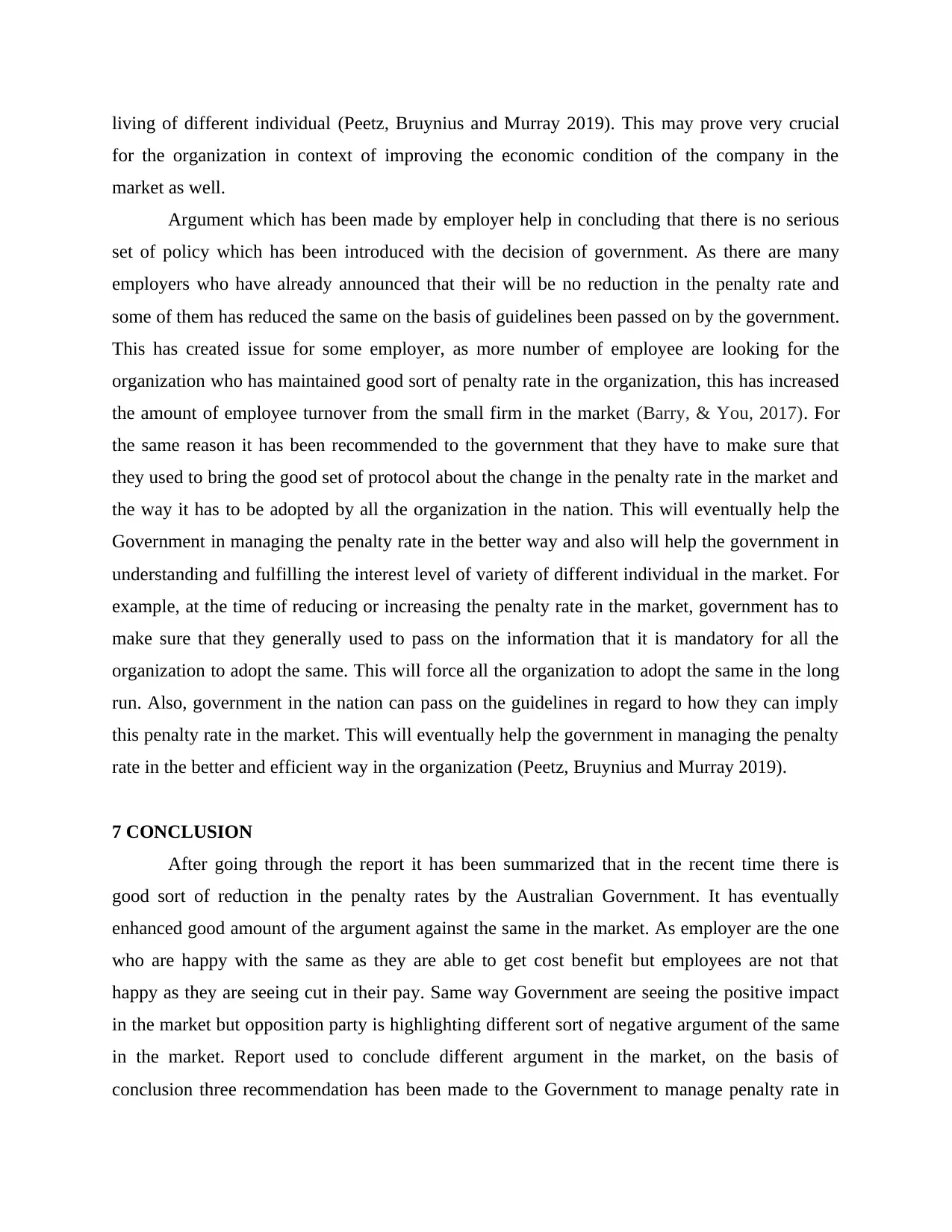
living of different individual (Peetz, Bruynius and Murray 2019). This may prove very crucial
for the organization in context of improving the economic condition of the company in the
market as well.
Argument which has been made by employer help in concluding that there is no serious
set of policy which has been introduced with the decision of government. As there are many
employers who have already announced that their will be no reduction in the penalty rate and
some of them has reduced the same on the basis of guidelines been passed on by the government.
This has created issue for some employer, as more number of employee are looking for the
organization who has maintained good sort of penalty rate in the organization, this has increased
the amount of employee turnover from the small firm in the market (Barry, & You, 2017). For
the same reason it has been recommended to the government that they have to make sure that
they used to bring the good set of protocol about the change in the penalty rate in the market and
the way it has to be adopted by all the organization in the nation. This will eventually help the
Government in managing the penalty rate in the better way and also will help the government in
understanding and fulfilling the interest level of variety of different individual in the market. For
example, at the time of reducing or increasing the penalty rate in the market, government has to
make sure that they generally used to pass on the information that it is mandatory for all the
organization to adopt the same. This will force all the organization to adopt the same in the long
run. Also, government in the nation can pass on the guidelines in regard to how they can imply
this penalty rate in the market. This will eventually help the government in managing the penalty
rate in the better and efficient way in the organization (Peetz, Bruynius and Murray 2019).
7 CONCLUSION
After going through the report it has been summarized that in the recent time there is
good sort of reduction in the penalty rates by the Australian Government. It has eventually
enhanced good amount of the argument against the same in the market. As employer are the one
who are happy with the same as they are able to get cost benefit but employees are not that
happy as they are seeing cut in their pay. Same way Government are seeing the positive impact
in the market but opposition party is highlighting different sort of negative argument of the same
in the market. Report used to conclude different argument in the market, on the basis of
conclusion three recommendation has been made to the Government to manage penalty rate in
for the organization in context of improving the economic condition of the company in the
market as well.
Argument which has been made by employer help in concluding that there is no serious
set of policy which has been introduced with the decision of government. As there are many
employers who have already announced that their will be no reduction in the penalty rate and
some of them has reduced the same on the basis of guidelines been passed on by the government.
This has created issue for some employer, as more number of employee are looking for the
organization who has maintained good sort of penalty rate in the organization, this has increased
the amount of employee turnover from the small firm in the market (Barry, & You, 2017). For
the same reason it has been recommended to the government that they have to make sure that
they used to bring the good set of protocol about the change in the penalty rate in the market and
the way it has to be adopted by all the organization in the nation. This will eventually help the
Government in managing the penalty rate in the better way and also will help the government in
understanding and fulfilling the interest level of variety of different individual in the market. For
example, at the time of reducing or increasing the penalty rate in the market, government has to
make sure that they generally used to pass on the information that it is mandatory for all the
organization to adopt the same. This will force all the organization to adopt the same in the long
run. Also, government in the nation can pass on the guidelines in regard to how they can imply
this penalty rate in the market. This will eventually help the government in managing the penalty
rate in the better and efficient way in the organization (Peetz, Bruynius and Murray 2019).
7 CONCLUSION
After going through the report it has been summarized that in the recent time there is
good sort of reduction in the penalty rates by the Australian Government. It has eventually
enhanced good amount of the argument against the same in the market. As employer are the one
who are happy with the same as they are able to get cost benefit but employees are not that
happy as they are seeing cut in their pay. Same way Government are seeing the positive impact
in the market but opposition party is highlighting different sort of negative argument of the same
in the market. Report used to conclude different argument in the market, on the basis of
conclusion three recommendation has been made to the Government to manage penalty rate in
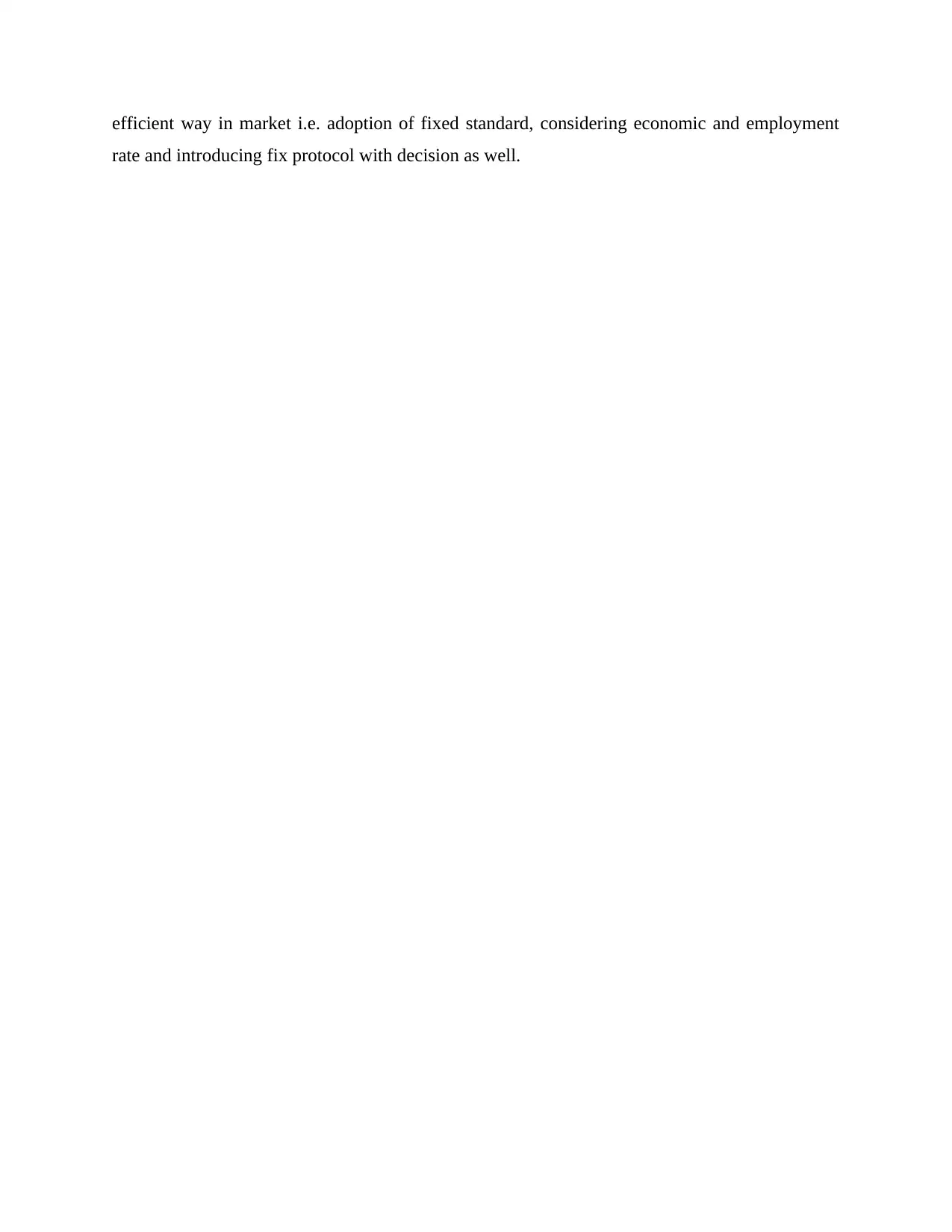
efficient way in market i.e. adoption of fixed standard, considering economic and employment
rate and introducing fix protocol with decision as well.
rate and introducing fix protocol with decision as well.
⊘ This is a preview!⊘
Do you want full access?
Subscribe today to unlock all pages.

Trusted by 1+ million students worldwide
1 out of 14
Related Documents
Your All-in-One AI-Powered Toolkit for Academic Success.
+13062052269
info@desklib.com
Available 24*7 on WhatsApp / Email
![[object Object]](/_next/static/media/star-bottom.7253800d.svg)
Unlock your academic potential
Copyright © 2020–2025 A2Z Services. All Rights Reserved. Developed and managed by ZUCOL.





